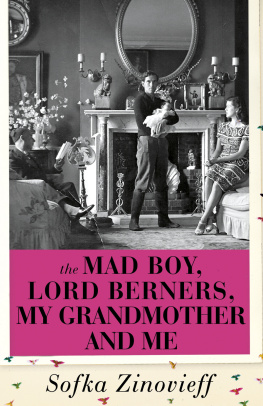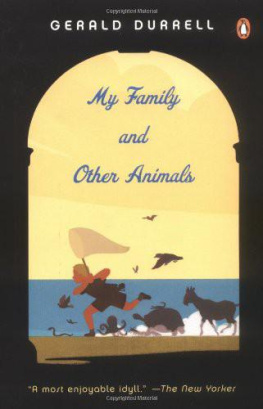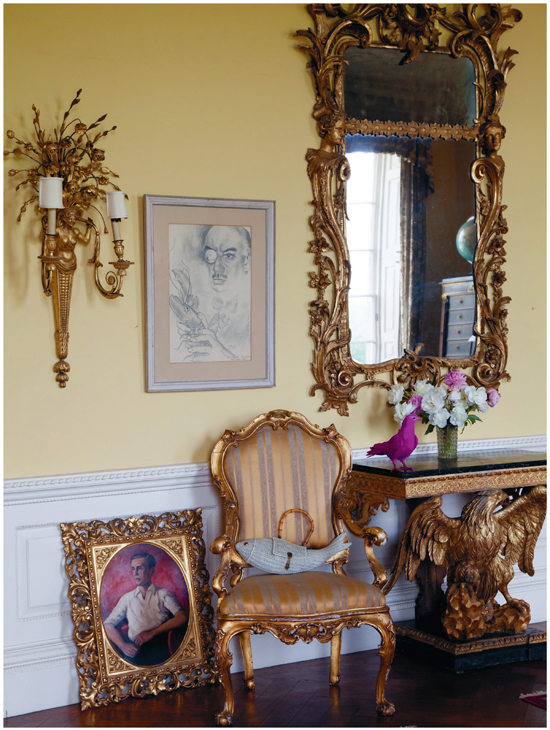Eurydice Street: A Place in Athens
Red Princess: A Revolutionary Life
The House on Paradise Street
Australia
HarperCollins Publishers (Australia) Pty. Ltd.
Level 13, 201 Elizabeth Street
Sydney, NSW 2000, Australia
www.harpercollins.com.au
Canada
HarperCollins Canada
2 Bloor Street East - 20th Floor
Toronto, ON M4W 1A8, Canada
www.harpercollins.ca
New Zealand
HarperCollins Publishers New Zealand
Unit D1, 63 Apollo Drive
Rosedale 0632
Auckland, New Zealand
www.harpercollins.co.nz
United Kingdom
HarperCollins Publishers Ltd.
1 London Bridge Street
London SE1 9GF, UK
www.harpercollins.co.uk
United States
HarperCollins Publishers Inc.
195 Broadway
New York, NY 10007
www.harpercollins.com
THE MAD BOY, LORD BERNERS, MY GRANDMOTHER AND ME . Copyright 2015 by Sofka Zinovieff. All rights reserved under International and Pan-American Copyright Conventions. By payment of the required fees, you have been granted the nonexclusive, nontransferable right to access and read the text of this e-book on-screen. No part of this text may be reproduced, transmitted, decompiled, reverse engineered, or stored in or introduced into any information storage and retrieval system, in any form or by any means, whether electronic or mechanical, now known or hereafter invented, without the express written permission of HarperCollins e-books.
Extract from Some People by Harold Nicolson reproduced by permission of the Harold Nicolson Estate. Lines from The Green Eyed Monster, words by Esther Duff, music by Lord Berners 1920 Chester Music Limited. All rights reserved. International copyright secured. Used by permission of Chester Music Limited.
Originally published in Great Britain in 2014 by Jonathan Cape, an imprint of The Random House Group Ltd.
FIRST U.S. EDITION
ISBN 978-0-06-233894-5
EPub Edition MARCH 2015 ISBN: 9780062338969
15 16 17 18 19 OFF / IMA 10 9 8 7 6 5 4 3 2 1
 T HE DRAWING ROOM AT F ARINGDON: PORTRAIT OF THE YOUNG R OBERT H EBER -P ERCY BY G ERALD B ERNERS ; PORTRAIT OF B ERNERS HOLDING A LOBSTER BY G REGORIO P RIETO ; J ENNIFERS FISH-SHAPED HANDBAG ON THE CHAIR, AND ONE OF THE PINK DOVES ON THE TABLE
T HE DRAWING ROOM AT F ARINGDON: PORTRAIT OF THE YOUNG R OBERT H EBER -P ERCY BY G ERALD B ERNERS ; PORTRAIT OF B ERNERS HOLDING A LOBSTER BY G REGORIO P RIETO ; J ENNIFERS FISH-SHAPED HANDBAG ON THE CHAIR, AND ONE OF THE PINK DOVES ON THE TABLE
 PRIL 2013, the coldest spring in England for half a century. I left Athens bathed in scented sunshine and landed at Heathrow to sleet sliding down the windows. Over the dozen years since I had settled in Greece with Vassilis, Anna and Lara, I had often travelled back to England and made my way to Faringdon. Occasionally, it was to stay in the house, but more often the house was occupied by tenants and I spent a couple of days with Leo and Annabelle in their nearby home, going over to Faringdon to make plans in the gardens with Andy and plough through the accounts and the latest problems in the estate office: a lead roof needing to be replaced, a historical group requesting a visit, the perimeter wall that has collapsed, the town sewage pipe which is gushing inexplicably, dangerously near the lake, just like it did in the 1930s... This time, though, Leo and his family were away in Scotland and I booked myself into a pub for a couple of days.
PRIL 2013, the coldest spring in England for half a century. I left Athens bathed in scented sunshine and landed at Heathrow to sleet sliding down the windows. Over the dozen years since I had settled in Greece with Vassilis, Anna and Lara, I had often travelled back to England and made my way to Faringdon. Occasionally, it was to stay in the house, but more often the house was occupied by tenants and I spent a couple of days with Leo and Annabelle in their nearby home, going over to Faringdon to make plans in the gardens with Andy and plough through the accounts and the latest problems in the estate office: a lead roof needing to be replaced, a historical group requesting a visit, the perimeter wall that has collapsed, the town sewage pipe which is gushing inexplicably, dangerously near the lake, just like it did in the 1930s... This time, though, Leo and his family were away in Scotland and I booked myself into a pub for a couple of days.
Id had a few drinks over the years at the Bell Hotel in Faringdons Market Place, but it never crossed my mind I might stay there. It smelled of beer and fried food and had the sombre hush of a winter afternoon before the first drinkers arrive. The landlady, Mel Gravestock, had a hennaed crew-cut and a nose stud and told me she and her husband had been managing the place for two years. Its tough work that never stops on duty twenty-four hours a day. The building is an old coaching inn, with sections apparently dating back to medieval times; there were narrow stairways and unevenly floored corridors to negotiate before we reached what had been described as the bridal suite. A low-beamed attic room, it gave on to rooftops and the back courtyard and offered a large, windowless bathroom with a beaten-up circular bathtub. The temperature felt sub-zero. On enquiring, it emerged that the heating oil had run out and wouldnt be delivered for two days. Electric fires were brought, blankets piled on. It could have been the beginning of one of Geralds stories. A camel might arrive at the front door, or a fur-wrapped marchesa pass by with her python in a glass travelling box, heading up towards Faringdon House. Perhaps a flock of vibrantly coloured birds would swoop down before returning to a magical place where a lord wears masks, plays music on a piano in his car and throws wild parties for the famous, rich and beautiful with a mad boy.
I had come to Faringdon this time to unveil a blue plaque. Recently, quite unexpectedly, an email had come from Eda Forbes, my ancient-history teacher from Oxford High School. I remembered her well a clever classicist with hair wound high on her head. She had been surprised to find me in her class. I had arrived at the school aged sixteen, a rebel from Wheatley Park Comprehensive following a move with my father to an Oxfordshire village where he had gone in search of the good life. Accustomed to the precociously erudite daughters of Oxford dons, Miss Forbes had looked at me sadly after my first homework assignment and said, Sofka, you dont know how to write an essay, do you? Now retired, she worked as secretary of the Oxfordshire Blue Plaques Board, which had agreed that Lord Berners should be honoured and that the ideal location was his tower on Folly Hill. She wondered if I could give a little speech.
The next morning, an icy wind was blustering around the hill as I walked up towards Geralds Folly. I was glad Id brought my old astrakhan coat, acquired decades before in a Soviet state outlet in Leningrad before it reverted to St Petersburg, as my Russian grandparents knew the place. A small crowd was gathering around the square brick base of the tower. Miss Forbes wore the additional decades very well and her hair was still arranged as I remembered. There were three mayors, including Oxfords, all of whom sported gleaming gold chains. A few journalists took notes and snapped photographs. Eddie Williams, the man who has galvanised an enthusiastic group of supporters into repairing, restoring and cherishing the Folly, was beaming with pleasure. There were all sorts of local people who have made this tower theirs, who walk their dogs, organise parties or take friends up on open days to look out across expanses of England.
Robert handed over the Folly to the town in the 1980s when it was at its crumbling nadir unsafe to enter and scarred by vandalism and graffiti. There were various attempts to patch it up over the years. When I inherited Faringdon House, I automatically became a trustee of the tower, along with the mayor and the accountant. Inevitably, I was influenced by the way Robert always treated the place, recalling how he would bump us up the track in his car to the tower after lunch, fumble with some keys in the thick, bank-vault door (put in after the other was destroyed), and let us creep up cautiously to the top and push open the trap-door to the viewing platform. I, in my turn, also kept a key and would take friends there. Some of my daughters birthdays were celebrated within the turreted top, with a cake and picnic carried up the creaking stairs. Now things are different. What began as one mans indulgence or as a gift to his wild young lover, is now a municipal amenity. There are information boards to explain the history, health and safety regulations, volunteers on a rota. Some of the romance might have been lost, but it is the exclusive romance associated with the old ways of privilege, inappropriate in this age.
Next page










 T HE DRAWING ROOM AT F ARINGDON: PORTRAIT OF THE YOUNG R OBERT H EBER -P ERCY BY G ERALD B ERNERS ; PORTRAIT OF B ERNERS HOLDING A LOBSTER BY G REGORIO P RIETO ; J ENNIFERS FISH-SHAPED HANDBAG ON THE CHAIR, AND ONE OF THE PINK DOVES ON THE TABLE
T HE DRAWING ROOM AT F ARINGDON: PORTRAIT OF THE YOUNG R OBERT H EBER -P ERCY BY G ERALD B ERNERS ; PORTRAIT OF B ERNERS HOLDING A LOBSTER BY G REGORIO P RIETO ; J ENNIFERS FISH-SHAPED HANDBAG ON THE CHAIR, AND ONE OF THE PINK DOVES ON THE TABLE PRIL 2013, the coldest spring in England for half a century. I left Athens bathed in scented sunshine and landed at Heathrow to sleet sliding down the windows. Over the dozen years since I had settled in Greece with Vassilis, Anna and Lara, I had often travelled back to England and made my way to Faringdon. Occasionally, it was to stay in the house, but more often the house was occupied by tenants and I spent a couple of days with Leo and Annabelle in their nearby home, going over to Faringdon to make plans in the gardens with Andy and plough through the accounts and the latest problems in the estate office: a lead roof needing to be replaced, a historical group requesting a visit, the perimeter wall that has collapsed, the town sewage pipe which is gushing inexplicably, dangerously near the lake, just like it did in the 1930s... This time, though, Leo and his family were away in Scotland and I booked myself into a pub for a couple of days.
PRIL 2013, the coldest spring in England for half a century. I left Athens bathed in scented sunshine and landed at Heathrow to sleet sliding down the windows. Over the dozen years since I had settled in Greece with Vassilis, Anna and Lara, I had often travelled back to England and made my way to Faringdon. Occasionally, it was to stay in the house, but more often the house was occupied by tenants and I spent a couple of days with Leo and Annabelle in their nearby home, going over to Faringdon to make plans in the gardens with Andy and plough through the accounts and the latest problems in the estate office: a lead roof needing to be replaced, a historical group requesting a visit, the perimeter wall that has collapsed, the town sewage pipe which is gushing inexplicably, dangerously near the lake, just like it did in the 1930s... This time, though, Leo and his family were away in Scotland and I booked myself into a pub for a couple of days.